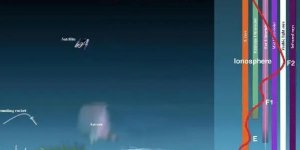| / Documentaries / Space |
What are Solar Storms & Space Weather?
Space
Geomagnetic storms, solar storms, sunspots, and solar flares belong to a set of phenomena known as "space weather".
Transcript
What is space weather? Space weather comes from the sun.
The sun is always emitting material solar, wind, plasma and shoots it off throughout the solar system. Our sun is a star like the many you see up in the sky at night. It's just way closer than those. About 93 million miles away.
The sun is a yellow dwarf star and is 10,000°F. It is an ordinary star, one of 100 billion stars in our own galaxy, the Milky Way.
The sun is the center of our solar system, and its gravity holds that solar system together. The energy of the sun is generated at its core.
The next layer is called the radioactive zone, and then the convection zone where hot air rises and cold air sinks like water boiling in a pot.
Energy continues to travel out to the photosphere, the visible surface of the sun.
Above that is the chromosphere and the corona, which stretches 5 million miles around the sun. Where space weather comes from. There are three common types of solar eruptive phenomenon. Sunspots, coronal mass ejections, and solar flares.
A sunspot is a temporary dark spot on the surface of the sun. It turns dark because it's much cooler than the surrounding area.
They are regions of very, very concentrated magnetic fields that get super twisted up, and they can grow and shrink and can change shape.
Coronal mass ejections are big solar eruptions and shoot lots of plasma and high electromagnetic field from the sun's corona.
The outermost layer of the sun, a solar flare, is a very bright flash of light that has very, very fast particles, energizing these small amounts of particles to almost the speed of light. So it's different from a coronal mass ejection, which is a very large eruption of billions of tons of material.
Solar flares and coronal mass ejections can be really disruptive to our satellites in space and electrical systems here on Earth.
Because of the electromagnetic fields.
To learn more about these fields, let's ask Doctor Carrie Black from the US National Science Foundation. She's a plasma physicist that studies the sun.
Doctor black, can you teach us about the solar magnetic fields?
Okay. What are solar magnetic fields?
Well, we're going to get into the basics of plasma physics with this.
So plasmas are collections of charged particles, so they're electrically charged particles.
And when they move, they create magnetic fields.
And the sun is made up of different types of plasma.
And it's really complicated on the sun because we have small scale magnetic fields. And then we have very, very large magnetic fields.
So I think everybody or most people are familiar with the idea of a magnetic field from a bar magnet in quiet times at solar minimum.
The sun is essentially a bar magnet.
The magnetic field is kind of like this, but because it's not a solid body, it's not made of a solid.
Materials made of this plasma, right?
It's twisting and moving.
And so the magnetic fields get all sorts of twisted up, which is what gives us things like, like sunspots and and coronal mass ejections.
Thank you, Doctor Black. That was very helpful.
So because the particles are so energetic during the different types of eruptions, when the waves of particles hit the satellite, it can damage the electrical systems and other components.
Studying the solar environment can be exciting because space weather changes every day. And with proper safety glasses, you can aobserve the sun to.





